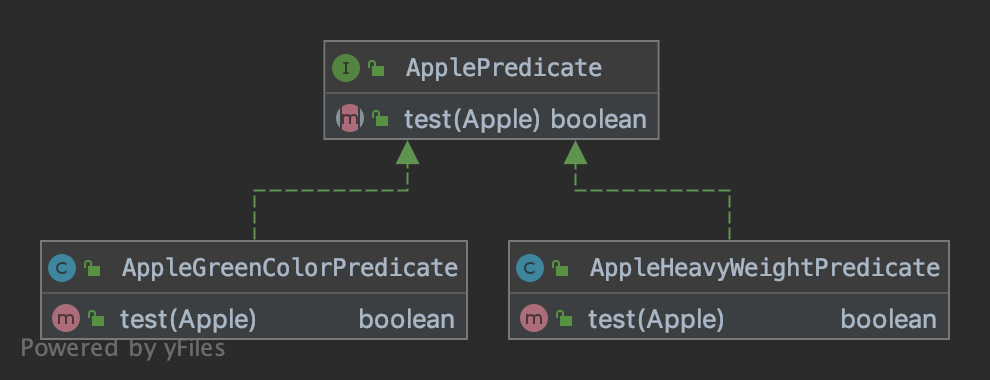Stratagy 패턴
19 Oct 2019 | DesignPatternStratagy(전략) 패턴
- 전략 패턴은 각 알고리즘을 캡슐화하는 알고리즘 패밀리를 정의해둔 다음에 런타임에 알고리즘(전략)을 선택하는 기법이다.
전략이란
- 어떤 목적을 달성하기 위해 일을 수행하는 방식, 비즈니스 규칙, 문제를 해결하는 알고리즘
사과를 필터링 하는 행위를 전략패턴으로 구현해보자.
요구사항 1) color = “green”인 사과를 구하라. 2) weight > 150인 사과를 구하라.
다음과 같은 요구사항이 있을 경우 가장 직관적인 방법은 요구사항별로 각각 구현하는 것이다.
public static void main(String[] args) {
List<Apple> apples = Arrays.asList(new Apple("green",80)
, new Apple("red",155)
, new Apple("yellow",122));
// 요구사항 1
List<Apple> greenApples = filterGreenApples(apples);
// 요구사항 2
List<Apple> heavyApples = filterHeavyApples(apples);
}
public static class Apple{
private String color = "";
private int weight = 0;
public Apple(String color, int weight) {
this.color = color;
this.weight = weight;
}
public String getColor() {
return color;
}
public void setColor(String color) {
this.color = color;
}
public int getWeight() {
return weight;
}
public void setWeight(int weight) {
this.weight = weight;
}
@Override
public String toString() {
return "Apple{" +
"color='" + color + '\'' +
", weight=" + weight +
'}';
}
}
public static List<Apple> filterGreenApples(List<Apple> apples){
List<Apple> result = new ArrayList();
for(Apple apple : apples){
if("green".equals(apple.getColor())){
result.add(apple);
}
}
return result;
}
public static List<Apple> filterHeavyApples(List<Apple> apples){
List<Apple> result = new ArrayList();
for(Apple apple : apples){
if(apple.getWeight() > 150){
result.add(apple);
}
}
return result;
}
그러나 요구사항이 계속 추가 될때마다 위 방식처럼 필터 메서드를 추가하는 방법이 좋은 방법일까? 당장 filterGreenApples() 메서드와 filterHeavyApples() 메서드만 보더라도 if문의 조건 한 줄을 제외하면 모두 중복된 코드로 이루어져 있다.
조건들을 클래스로 캡슐화하고 조건이 바뀔때마다 클래스를 동적으로 바꿔칠 수 있다면 중복없이 코드를 작성 할 수 있을 것이다.
구현 방법은 아래와 같다.
// 인수로 값을 받아 true나 false를 반환하는 함수를 predicate라 한다.
public interface ApplePredicate {
boolean test(FilteringApplesClone.Apple apple);
}
public class AppleGreenColorPredicate implements ApplePredicate {
@Override
public boolean test(FilteringApplesClone.Apple apple) {
return "green".equals(apple.getColor());
}
}
public class AppleHeavyWeightPredicate implements ApplePredicate {
@Override
public boolean test(FilteringApplesClone.Apple apple) {
return apple.getWeight() > 150;
}
}
public static List<Apple> filterByApplePredicate(List<Apple> apples, ApplePredicate p) {
List<Apple> result = new ArrayList<>();
for(Apple apple : apples){
if(p.test(apple)){ // Predicate
result.add(apple);
}
}
return result;
}
이를 다이어그램으로 표현하면 다음과 같다.

ApplePredicate 인터페이스는 구현체(AppleGreenColorPredicate, AppleHeavyWeightPredicate)를 캡슐화한다. 즉,런타임 시점까지 어떠한 알고리즘을 선택할지 은닉화한다.
AppleHeavyWeightPredicate, AppleGreenColorPredicate 클래스를 전략이라 하고 ApplePredicate 인터페이스처럼 전략을 캡슐화하는 객체를 알고리즘 패밀리라 한다.
public static void main(String[] args){
// 런타임에 어떤 전략을 선택할 지 선택할 수 있다.
List<Apple> filteredByGreenColor = filterByApplePredicate(apples, new AppleGreenColorPredicate());
List<Apple> filteredByfilterByWeight = filterByApplePredicate(apples, new AppleHeavyWeightPredicate());
}
ref. https://gmlwjd9405.github.io/2018/07/06/strategy-pattern.html
ref. http://www.hanbit.co.kr/store/books/look.php?p_code=B1999551123

 jayyhkwon의 개발공부로그
jayyhkwon의 개발공부로그